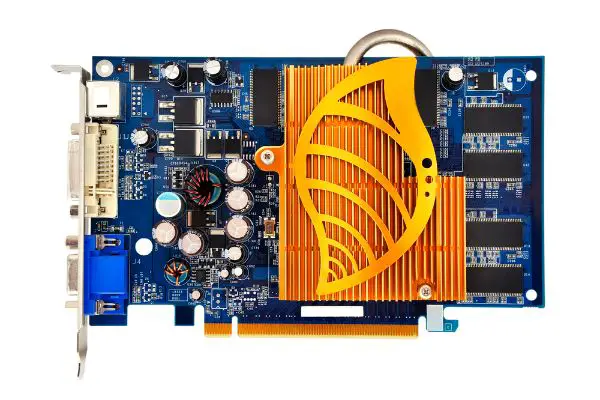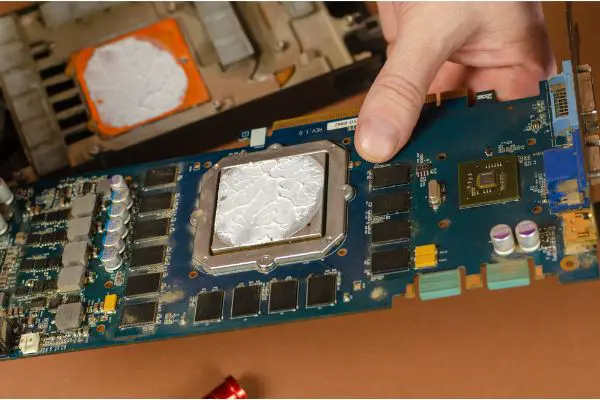Disclaimer: This post may contain affiliate links, meaning we get a small commission if you make a purchase through our links, at no cost to you. For more information, please visit our Disclaimer Page.
The graphics processor in your computer is the primary component that allows your display to render colors, textures, and other things in a clear, high-resolution format that looks good.
Different GPUs will have various specifications that will determine how high the frames can go, what sorts of programs you can run, and the settings on which you can play many of your favorite games. However, all such processors, if they are separate, dedicated cards, make use of video random-access memory in order to function.
VRAM is the sister memory of the system processor’s RAM, and many applications need a minimum amount of it in order to run. Some gamers or hobbyists may wonder if VRAM gets too hot when it is in use. We will discuss whether VRAM could benefit from cooling, how hot it might get, ideal temperatures for it, and possible things that might happen should yours overheat. We’ll also tackle whether you can use thermal paste on VRAM.
Table of Contents
Does GPU VRAM Need Cooling?
Whether GPU VRAM needs cooling may depend on the specific make and model of your card. Some older cards may not run hot enough to need it, and they may not have temperature sensors at all. That said, it doesn’t hurt to have some cooling on VRAM. This is mainly due to the memory’s relative proximity to the GPU.
The graphics processor itself can run hot, and as it gives off heat, that heat can soak the VRAM. It isn’t a bad idea to have some kind of cooler that can siphon off that heat in order to make sure that the chips stay at a decent temperature for smooth operations.
You may find that some fellow hobbyists don’t use any kind of cooling on the VRAM modules themselves. While it may be possible to get away with this, there is cooling on the voltage regulator modules, or VRM.
As the name suggests, these components help to make sure that the current going through the chips as they receive data doesn’t go over a limit that they cannot handle. In order to make sure that these critical components continue to do their jobs well, some cooling method is necessary.
VRAM is different from system RAM for the CPU, however. The latter doesn’t usually require its own dedicated cooling method. Regular RAM should not get hot enough to warrant a cooler, and there is probably an issue you would need to take care of if it does so on a consistent basis.
Because of its proximity to the graphics processor, however, VRAM does take on more heat than its counterpart. If you can mount an adequate cooler to provide better airflow for the VRAM, particularly on a high-performance graphics card, it is a good idea to do so.
Can VRAM Get Too Hot?
There is a possibility that VRAM can get too hot. Every manufacturer has different specifications as to the recommended temperature ranges for their GPUs or VRAM, and it is a good idea to make sure that your computer can keep things within those ranges.
This is particularly true if you are planning to run resource-intense programs for a long time. The processor may have to work hard for hours on end, and it will be giving off heat close to the VRAM. Therefore, there are scenarios in which the VRAM could get too hot.
However, most VRAM is rated to withstand temperatures that can go near 100 degrees Celsius when it comes to the maximum range. It isn’t necessarily a good idea to let either the graphics processor or the video random-access memory run at these temps for long periods of time, but the ratings mean that they shouldn’t overheat.
As always, it is best to check the manufacturer’s recommendations for the specific make and model of your card or VRAM for the most accurate information about the performance levels of these components.
Without its own cooling source, it may be more likely that the VRAM in your system could get too hot when the processor runs for a long time. There are ways to track the heat coming from the inside of your rig, and you can use programs to see what those levels are.
If you notice that the VRAM is getting toward the upper end of its recommended temperature range, consider letting the system take a break to cool down for a while.
Note, too, that graphics processor temperatures can be quite different from VRAM temperatures. The GPU might not get nearly as hot as the VRAM, even when it is running a game on high specifications. Therefore, don’t rely on the graphics processor’s readings to determine the VRAM ones.
What Is a Good VRAM Temperature?
What constitutes a good temperature for your video random-access memory can depend on the make and model that you choose. However, you’ll see most good ratings hover somewhere between 75 Celsius at the low end, with 95 Celsius at the upper end. Even though most VRAM is rated to go up to or a bit over 100 degrees Celsius, it is not a good idea to let the chips run at that temperature for too long.
Furthermore, although it should be fine to run your VRAM at temperatures in the upper range mentioned above, doing so could shorten the life of the VRAM. Some VRAM chips like to run hot, but most computer components run smoother and last longer when the temps are cooler.
There is also a minimum range for heat when it comes to computer parts, but cooler generally means better for the longevity of the components. If you find that your video random-access memory runs in the upper range of its accepted temperatures regularly, you may wish to consider adding some kind of cooler to bring those numbers down.
What Happens When VRAM Overheats?
As we noted, video random-access memory temps can be quite high without impeding the chips too much, and they can run higher than most people would want their actual GPU temps to be. However, there might be occasions where VRAM chips do exceed the maximum recommended temperatures.
If they do this for too long, the sensitive electronic components inside may overheat. What can happen in these scenarios could depend on what type of card you have, but there are a few educated guesses we can make here:
1. The graphics processor will throttle things down as a way to try to compensate for the heat buildup. This can mean stuttering or other issues that serve as markers of lower performance.
2. In more extreme cases, the GPU may freeze entirely, causing applications you are using to freeze with it. You may have to close some programs and wait before opening them again.
3. The processor may freeze up to the point where it forces a shutdown of the whole system. If this happens, you may wish to wait for everything to cool off before you restart your computer.
4. If the overheating is minor or temporary, you may see artifacts or tearing in any graphics-related program that tries to render videos or images.
5. Parts of the VRAM’s chips could burn to the point that it is hard or impossible for the video random-access memory to do its job. In such cases, you may have trouble running any program with intense graphics at all, and replacing the VRAM would be vital.
Can You Use Thermal Paste on VRAM?
Yes, you can use thermal paste on VRAM, but it may not be the best option. Thermal paste is meant to fill in gaps between surfaces that are not even.
On something like a heatsink for a regular processor, there are many microscopic pits that are hard to see, and the paste helps with conducting heat away from the CPU by making the surface smoother. In theory, the same things could apply to VRAM chips.
However, VRAM chips have very small surface areas where you would apply the paste. Depending on the make and model of your card, we could be looking at contact surfaces of less than one millimeter.
Trying to apply a substance like paste to these areas could get messy quickly. If you are not careful, it is possible that you’ll accidentally insulate parts of the VRAM instead of cooling the chips off.
This is because paste that is applied in a way that makes it too clogged or sticky can fail to help it release heat.
For a different approach, you can try thermal pads that are made for the specific size of VRAM contact points that you need. Many are very small, and you may be able to modify them to suit the memory of your choice. In these cases, it could be possible to apply a tiny amount of thermal paste to act as an adhesive that helps to hold the pads in place, too.
Conclusion
VRAM is a core component of how modern graphics engines display things in computers today. It is necessary for some resource-intensive applications, and different VRAM works with different cards or setups.
Although most video random-access memory you will find does run at some pretty high temperatures without issues, there is a possibility that it can become too hot. Adding cooling methods, keeping an eye on those temps, and being mindful of what can happen if VRAM overheats can help you extend the life of your memory chips.


